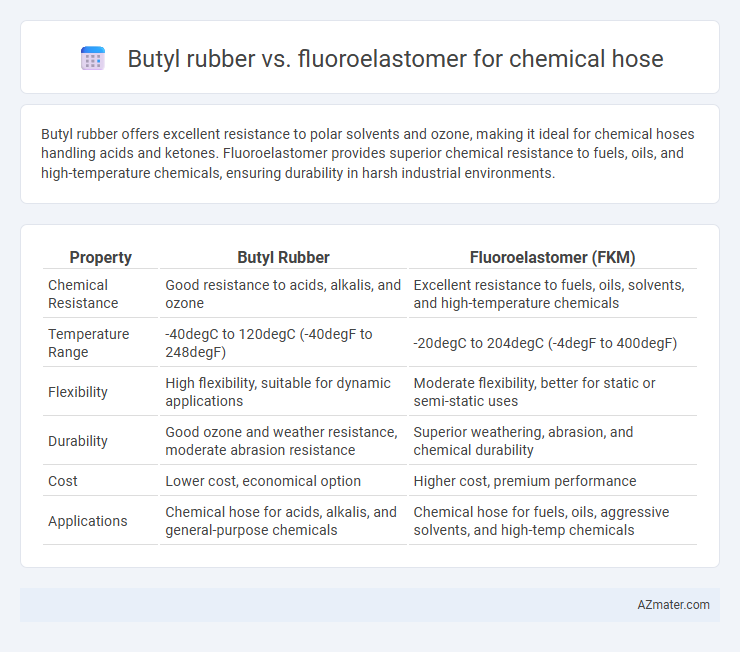Butyl rubber offers excellent resistance to polar solvents and ozone, making it ideal for chemical hoses handling acids and ketones. Fluoroelastomer provides superior chemical resistance to fuels, oils, and high-temperature chemicals, ensuring durability in harsh industrial environments.
Table of Comparison
| Property | Butyl Rubber | Fluoroelastomer (FKM) |
|---|---|---|
| Chemical Resistance | Good resistance to acids, alkalis, and ozone | Excellent resistance to fuels, oils, solvents, and high-temperature chemicals |
| Temperature Range | -40degC to 120degC (-40degF to 248degF) | -20degC to 204degC (-4degF to 400degF) |
| Flexibility | High flexibility, suitable for dynamic applications | Moderate flexibility, better for static or semi-static uses |
| Durability | Good ozone and weather resistance, moderate abrasion resistance | Superior weathering, abrasion, and chemical durability |
| Cost | Lower cost, economical option | Higher cost, premium performance |
| Applications | Chemical hose for acids, alkalis, and general-purpose chemicals | Chemical hose for fuels, oils, aggressive solvents, and high-temp chemicals |
Introduction to Chemical Hose Materials
Butyl rubber offers excellent resistance to gases and weathering, making it suitable for chemical hoses transporting low to moderate levels of aggressive chemicals. Fluoroelastomer chemical hoses provide superior chemical resistance, especially against fuels, oils, and solvents, maintaining durability under high temperature and harsh environments. Selecting between butyl rubber and fluoroelastomer depends on the specific chemical compatibility, temperature range, and flexibility requirements of the application.
Overview of Butyl Rubber Properties
Butyl rubber exhibits excellent resistance to gases, ozone, and weathering, making it a preferred material for chemical hoses requiring airtight and durable performance. Its low permeability to air and good elasticity ensure long-lasting flexibility and resilience under various environmental conditions. These properties distinguish butyl rubber from fluoroelastomers, which are more resistant to high temperatures and aggressive chemicals but less flexible and more expensive.
Overview of Fluoroelastomer Properties
Fluoroelastomer excels in chemical hose applications due to its exceptional resistance to a wide range of aggressive chemicals, high temperatures up to 200-250degC, and superior aging and weathering stability compared to Butyl rubber. Its molecular structure endows it with excellent oil, fuel, and solvent resistance, making it ideal for harsh environments where Butyl rubber may degrade or lose flexibility. Fluoroelastomer's low permeability and outstanding mechanical properties ensure long service life and reliability in demanding chemical transfer operations.
Chemical Resistance Comparison
Butyl rubber exhibits excellent resistance to polar solvents, acids, and alkalis, making it suitable for many chemical hose applications involving oxygen, ketones, and water-based fluids. Fluoroelastomers outperform butyl rubber with superior resistance to a broader range of aggressive chemicals, including hydrocarbons, oils, fuels, and high-temperature solvents, commonly encountered in industrial chemical transfer. Fluoroelastomer chemical hoses maintain integrity under extreme conditions, whereas butyl rubber may degrade faster when exposed to aromatic hydrocarbons and concentrated solvents.
Temperature Tolerance Differences
Butyl rubber chemical hoses typically tolerate temperatures up to 120degC (248degF), making them suitable for moderate heat applications. Fluoroelastomer hoses withstand significantly higher temperatures, often ranging from -40degC to 205degC (-40degF to 401degF), providing superior performance in extreme thermal environments. This temperature tolerance difference makes fluoroelastomer the preferred choice for high-heat chemical processing and aggressive chemical exposure areas.
Mechanical Strength and Durability
Butyl rubber offers excellent mechanical strength with high tensile strength and good abrasion resistance, making it suitable for chemical hoses exposed to physical stress. Fluoroelastomers provide superior chemical resistance and sustained durability under extreme temperatures and aggressive chemical environments, ensuring long service life in harsh industrial applications. Selecting between Butyl rubber and Fluoroelastomer depends on the balance required between mechanical robustness and chemical durability for specific hose applications.
Flexibility and Handling
Butyl rubber offers excellent flexibility and ease of handling, making it ideal for chemical hoses requiring frequent bending and maneuverability. Fluoroelastomers provide superior chemical resistance but are generally stiffer, resulting in reduced flexibility and more challenging handling during installation. Choosing between butyl rubber and fluoroelastomer depends on balancing flexibility needs with chemical exposure requirements in hose applications.
Cost and Availability
Butyl rubber chemical hoses are generally more cost-effective due to lower raw material and manufacturing expenses, making them suitable for budget-sensitive applications. Fluoroelastomer hoses, while significantly more expensive, provide superior chemical resistance and durability in aggressive environments, justifying the higher initial investment for specialized uses. Availability of butyl rubber hoses is widespread due to established production, whereas fluoroelastomer hoses may have limited supply and longer lead times because of complex formulation requirements.
Typical Applications in Chemical Transfer
Butyl rubber excels in chemical hose applications requiring resistance to polar solvents, gases, and acids, typically used in transferring ketones, esters, and dilute acids. Fluoroelastomer offers superior chemical resistance to fuels, oils, and aggressive chemicals, making it ideal for handling harsh chemicals like gasoline, diesel, and aromatic hydrocarbons. Both materials ensure optimal performance in chemical transfer, with butyl rubber suited for moderate chemical exposure and fluoroelastomer preferred for high-temperature and aggressive chemical environments.
Choosing the Right Material for Your Chemical Hose
Choosing the right material for your chemical hose depends on the chemical compatibility and operating conditions; butyl rubber offers excellent resistance to gases, ozone, and organic solvents, making it suitable for applications involving dilute acids and alkalis. Fluoroelastomer, known for superior chemical and temperature resistance, withstands aggressive chemicals, fuels, and high-temperature fluids, ideal for harsh industrial environments. Assessing factors like temperature range, chemical exposure, and flexibility ensures optimal performance and longevity in chemical hose applications.

Infographic: Butyl rubber vs Fluoroelastomer for Chemical hose
 azmater.com
azmater.com